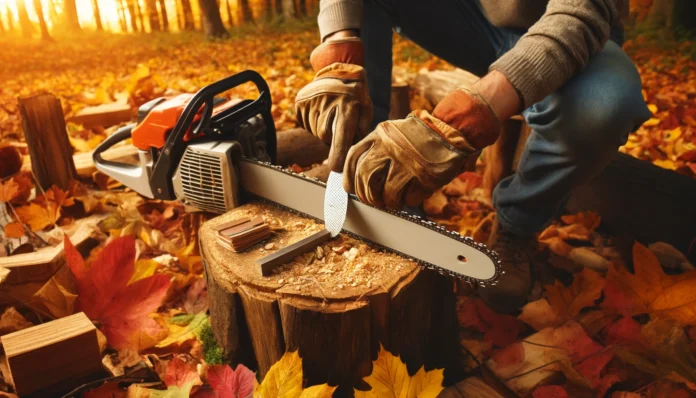A dull chainsaw blade is more than just an inconvenience; it’s a safety hazard. It increases the risk of kickback, reduces cutting efficiency, and puts unnecessary strain on your saw. Fortunately, sharpening your chainsaw blade is a skill you can easily master with the right tools, techniques, and a bit of practice. This comprehensive guide will walk you through everything you need to know to revitalize your chainsaw blade and achieve optimal cutting performance.
Why a Sharp Chainsaw Blade is Essential
A sharp chainsaw blade is crucial for several reasons:
- Safety: A dull blade is more prone to kickback, a dangerous situation where the saw violently recoils towards the operator.
- Efficiency: A sharp blade cuts through wood effortlessly, saving you time and energy.
- Longevity: A well-maintained blade lasts longer, reducing the frequency of replacements.
Signs Your Chainsaw Blade Needs Sharpening
Before you start sharpening, it’s important to identify the signs of a dull blade:
- Sawdust instead of wood chips: A sharp blade produces clean wood chips, while a dull blade produces fine sawdust.
- Uneven cuts: A dull blade tends to wander or produce uneven cuts.
- Binding in the wood: A dull blade may bind or get stuck in the wood, requiring more force to cut.
Understanding Chainsaw Chain Types
There are two main types of chainsaw chains:
- Full chisel: These chains have square-cornered teeth for aggressive cutting in clean wood. They require more frequent sharpening.
- Semi-chisel: These chains have rounded-cornered teeth for better durability and less frequent sharpening. They are ideal for dirty or frozen wood.
Gathering the Essential Tools and Materials
Before you begin sharpening, gather the following tools and materials:
- Round file (matching your chain’s pitch)
- Flat file
- Depth gauge tool
- Vise or chainsaw sharpening clamp
- Bar groove cleaner
- Safety gloves and glasses
Prioritizing Safety During the Sharpening Process
Chainsaw sharpening involves sharp tools and a powerful machine. Always prioritize safety by:
- Disconnecting the spark plug or battery.
- Wearing protective gear, including gloves, glasses, and sturdy footwear.
- Securing the chainsaw in a vise or clamp.
- Handling files and tools with care.
Mastering Manual Chainsaw Sharpening
Manual sharpening is the most common method and involves using a round file:
- Identify the shortest cutter: This will be your reference point for consistent sharpening.
- Use a filing guide: This ensures the correct filing angle and depth.
- Maintain consistent pressure and pattern: File each cutter with the same number of strokes and pressure.
- Sharpen one side, then flip: Sharpen all cutters on one side, then flip the chainsaw and repeat on the other side.
- Check and adjust depth gauges: Use a depth gauge tool to ensure consistent depth across all cutters.
Exploring Electric Chainsaw Sharpeners
Electric sharpeners offer speed, precision, and ease of use:
- Bench-mounted sharpeners: These are ideal for frequent sharpening and high-volume work.
- Handheld sharpeners: These are portable and convenient for occasional sharpening.
Choose the right grinding wheel for your chain type and follow the manufacturer’s instructions for safe operation.
Troubleshooting Common Sharpening Issues
If you encounter issues like uneven cutter lengths, incorrect angles, or over-sharpening, refer to troubleshooting guides or seek professional help.
Maintenance Tips for a Long-Lasting Blade
To prolong the life of your chainsaw blade:
- Regularly clean the bar and chain.
- Use the correct bar oil for lubrication.
- Avoid cutting dirty or abrasive materials.
- Store the chainsaw in a dry and safe place.
By following this comprehensive guide, you’ll be well on your way to becoming a chainsaw sharpening expert. Remember, practice makes perfect, so don’t be discouraged if it takes a few tries to get the hang of it. With a sharp blade, you’ll enjoy safer, more efficient cutting and prolong the life of your chainsaw.



